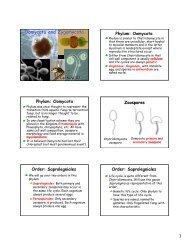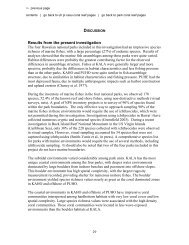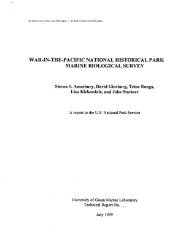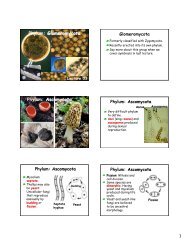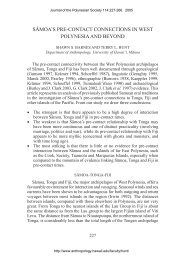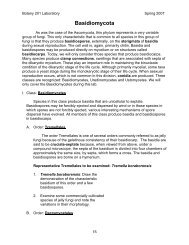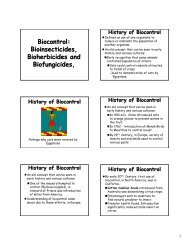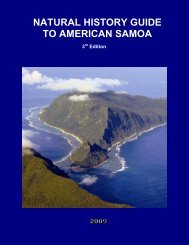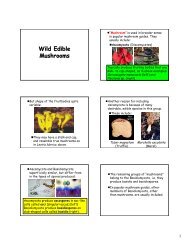american samoa - University of Hawaii at Manoa Botany Department
american samoa - University of Hawaii at Manoa Botany Department
american samoa - University of Hawaii at Manoa Botany Department
- No tags were found...
You also want an ePaper? Increase the reach of your titles
YUMPU automatically turns print PDFs into web optimized ePapers that Google loves.
South <strong>of</strong> this narrow zone and north <strong>of</strong> the plant<strong>at</strong>ion area behind the occupied house, there wasa small taro plant<strong>at</strong>ion growing on an artificial island deline<strong>at</strong>ed by rock embankments. Themost common weed among the taro plants was a<strong>at</strong>asi (Polynesian cress), a plant <strong>of</strong>considerable importance in traditional Samoan medicine. However, no tamole vai was found inthis area.Veget<strong>at</strong>ion TrendsIn 1993, Biosystems Analysis, Inc. recorded beach hibiscus as the dominant plant within thewetland. Beach hibiscus is a swamp species r<strong>at</strong>her than a marsh species; swamps are typicallydomin<strong>at</strong>ed by trees while marshes are domin<strong>at</strong>ed by herbs. Six years l<strong>at</strong>er, beach hibiscus hadtaken over most <strong>of</strong> the wetland in November 1999. Increased shade within the wetlandelimin<strong>at</strong>ed the typically shade-tolerant marsh species. Only a small amount <strong>of</strong> swamp fern andeven less marsh fern was present in the wetland. No w<strong>at</strong>er chestnut was documented.In November 1999, no falaga (Barringtonia samoensis) or ifi (Tahitian chestnut), which aretrees characteristic <strong>of</strong> wetlands on the Island <strong>of</strong> Tutuila, were recorded by the PPC survey team.PPC believes th<strong>at</strong> the Fusi wetland margin may have once domin<strong>at</strong>ed by fau and falaga. Afterthe arrival <strong>of</strong> humans on Tau, ifi may also have been present. These large-seed species wouldnot easily disperse to the site without human intervention.The wettest areas <strong>of</strong> the wetland are not conducive to the growth <strong>of</strong> swamp forest as herbsdomin<strong>at</strong>e. Consequently, the wetland interior is a marsh r<strong>at</strong>her than a swamp. Marsh specieswould typically include marsh species such as utuutu (w<strong>at</strong>er chestnut) and vao tuaniu (marshfern).This wetland was probably once under cultiv<strong>at</strong>ion. Surface run<strong>of</strong>f and/or a spring furnishedw<strong>at</strong>er needed for past taro cultiv<strong>at</strong>ion. When cultiv<strong>at</strong>ion discontinued, the wetland became adisturbed marsh. Whistler observed a disturbed marsh condition in 1976; willow primrose wasdocumented within the site <strong>at</strong> th<strong>at</strong> time.In the absence <strong>of</strong> human intervention, it is expected th<strong>at</strong> beach hibiscus swamp forest willremain dominant for a long time. The only possible competition might come from the saplings,e.g., afa. However, only afa is <strong>of</strong>ten associ<strong>at</strong>ed with wetlands. Consequently, a few sc<strong>at</strong>teredlowland forest trees may gain a precarious foothold in places with a slightly higher elev<strong>at</strong>ion, oron rock outcrops.AQUATIC FISH AND INVERTEBRATESGeneralOn November 9, 1999, Charles Chong <strong>of</strong> the PPC field survey team made observ<strong>at</strong>ions <strong>of</strong> theFusi wetland. His observ<strong>at</strong>ions are summarized in the following paragraphs.No flowing w<strong>at</strong>er was observed within the Fusi wetland. There was standing w<strong>at</strong>er in severalpools under heavy foliage. A thick layer <strong>of</strong> allochthonous m<strong>at</strong>erial had collected on top <strong>of</strong> asignificant volume <strong>of</strong> solid wastes below these pools. Because <strong>of</strong> the heavy canopy and solidwaste m<strong>at</strong>erial below the pools, visibility was limited. However, no macr<strong>of</strong>aunal organismswere observed during the survey.Onsite observ<strong>at</strong>ions indic<strong>at</strong>e th<strong>at</strong> w<strong>at</strong>er within the pools was percol<strong>at</strong>ing into the substr<strong>at</strong>a andpossibly seeping into the nearshore w<strong>at</strong>ers <strong>of</strong> nearby Tau Harbor. A noticeable fresh-w<strong>at</strong>er lenswithin the harbor was observed via snorkeling within the harbor w<strong>at</strong>ers.American Samoa Wetlands/Streams Restor<strong>at</strong>ion and Enhancement PlanFebruary 2001, Fusi Wetland, Page 11-5



